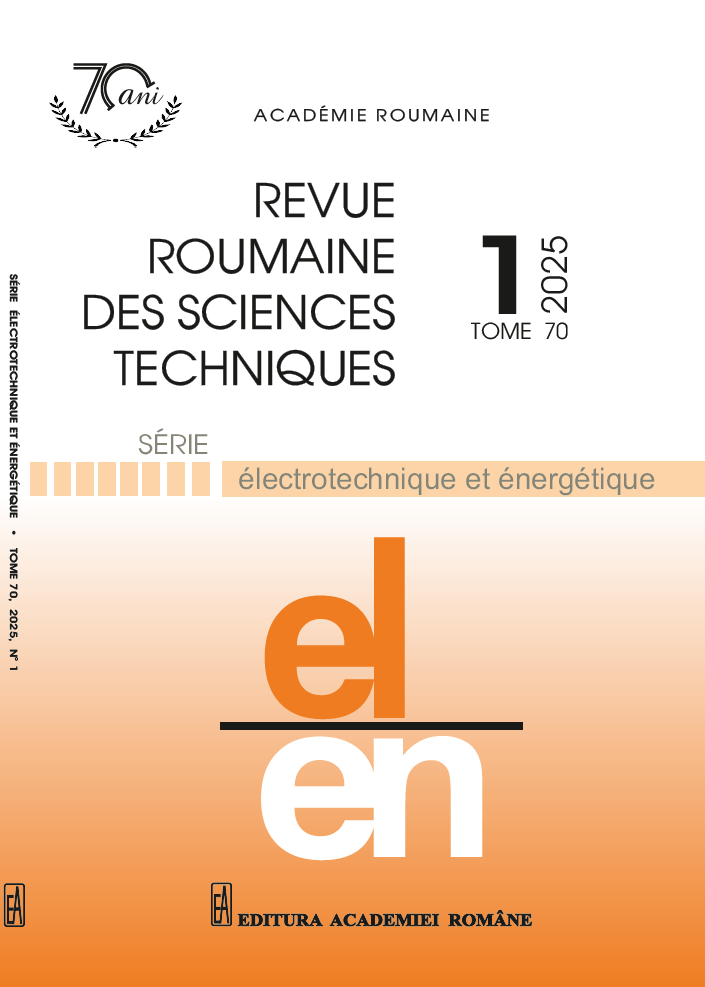ÉTUDE DE LA STATION DE POMPAGE AUTOMATISÉE AVEC SON ENTRAÎNEMENTSTUDY OF THE AUTOMATED PUMPING STATION WITH ITS DRIVE
DOI :
https://doi.org/10.59277/RRST-EE.2025.1.23Mots-clés :
Station de pompage, Schémas d’alimentation des moteurs, Pression, Point dicté , Facteur de puissanceRésumé
Des entreprises industrielles modernes, en particularité celles métallurgiques et de cokerie, comprennent un réseau maillé de stations de pompage et de compresseur. En qualité des moteurs d’entraînement on utilise largement des machines à courant alternatif : les moteurs asynchrones à cage d’écureuil (MA) et les moteurs synchrones (MS). Les puissances de moteurs d’entraînement sont dans l’intervalle des dizaines-centaines aux quelques milles kilowatt. Le réglage de la productivité est réalisé par des soupapes d’étranglement, la fréquence de rotation des moteurs ainsi reste invariable. Les indices énergétiques de telles commandes électriques à charge variable ont une tendance à diminuer par rapport aux nominaux. L’industrie électromécanique a proposé les convertisseurs de fréquence à haute puissance ce qui a permis de passer aux systèmes de commande électrique à basse consommation énergétique pour les stations de pompage : une machine est alimentée du réseau et une autre – du convertisseur de fréquence en assurant la pression prédéterminée au point dicté de la tuyauterie. Les schémas de différents branchements de machines sont considérés, aussi bien qu’une possibilité de maintenir le facteur de puissance au niveau optimal.
Références
(1) L.N. Gumilyov, Improvement of the automated control system of the oil pumping station, Bulletin of Eurasian National University Technical Science and Technology, 138, 1, pp. 15–22 (2022).
(2) B.S. Leznov, Energy Saving and Adjustable Drive in Pumps and Blower Units, (in Russian) Energoatomizdat, Moscow (2006).
(3) A.I. Repnikov, A.A. Yakovlev, M.P. Kukhtik, V.G. Barabanov, Automated Control System for a Second-Lift Pumping Station (in Russian), Industrial ACS and Controllers (2006).
(4) A.I. Repnikov, A.A. Yakovlev, M.P. Kukhtik, V.G. Barabanov, Automated control system for the second lift pumping station (in Russian), Industrial ACS and controllers, 1, pp. 7–15 (2024).
(5) I.O. Kiselev, L.I., Medvedeva, Analysis of the automated control system of a pumping station (in Russian), Science Diary, 2, 74, 21 (2023).
(6) M.M. Gayfullina, G.Z. Nizamova, Methodical approach to efficiency assessment of pumping equipment of oil pumping stations, Problems of Gathering Treatment and Transportation of Oil and Oil Products, Proc. of the IVth Int. Conf. on Adv. in Science, Engineering, and Digital Edu., ASEDU-IV, Navoi, Uzbekistan (29–31 May 2024).
(7) V.F. Borisenko, A.B. Katz, G.A. Pimenov, M.N. Godetsky, I.I. Poklad, On the transition to a resource-saving electric drive system in group pumping units (in Russian), Progressive technologies and systems of mechanical engineering: Int. Collection of Scientific Papers, 16, pp. 100–125 (2001).
(8) V.F. Borisenko, I.I. Poklad, S.V. Grigoriev, et al., Study of the dynamics of a group pumping station with electric drives using a frequency converter – asynchronous motor system to stabilize the output pressure (in Russian), Mechanical Engineering and Technosphere of the 21st Century, Sevastopol, September 8-14 (2003).
(9) V.F. Borisenko, I.I. Poklad, S.V. Grigoriev, et al., Operating modes of a group pumping station considering the efficiency factor and main hydraulic parameters, Explosion-proof electrical equipment (in Russian): Collection of scientific papers of Ukraine, pp. 161–165 (2003).
(10) R. Jiang, Y. Zhang, J. Zhu, B. Chen, Y. Tang, X. Yang, Y. Zheng, H. Duan, Optimization of pumping station inlet channel based on stress-blended eddy simulation turbulence model and entropy generation theory (in Russain), Water, 17, pp. 378 (2025).
(11) V.F. Borisenko, V.P. Ovsyannikov, I.I. Poklad, et al., Dynamics of the electromechanical system frequency converter – asynchronous motor with short-circuit rotor – pump considering non-stationary flow in a pipeline, Mechanical Engineering and Technosphere of the 21st Century, Sevastopol, September 8–14 (2003).
(12) K. Ostad‐Ali‐Askari, F. Sadeghi, H.R. Vanani, M.J. Monem, P. Kianmehr, Evaluation of variable frequency drive system in pumping stations of irrigation networks using INACSEM model, Irrigation and Drainage (2025).
(13) M.V. Shipunov, A.S. Salamatin, G.V. Makarov, et al., Evaluation of pre-emergency states of process equipment and control and measuring instruments (in Russian), Industrial ACS and Controllers, 3, pp. 16–24 (2020).
(14) X. Sun, X. Feng, Application of intelligent algorithms in optimal operation of pumping stations, Journal of Physics: Conference Series, IOP Publishing, 2854, 1, pp. 012044 (2024).
(15) Y. Zhao, et al., Unit operation combination and flow distribution scheme of water pump station system based on genetic algorithm, Applied Sciences, 13, 21, pp. 11869 (2023).
(16) D. Grenier, F. Labrique, H. Buyse, E. Matagne, Electromécanique. Convertisseurs d’Énergie et Actionneur, Dunod, Paris (2001).
(17) W. Leonard, Control of Electrical Drives, Springer, Berlin (1997).
(18) B. Amin, Induction Motors. Analysis and Torque Control, Springer, Berlin (2002).
(19) A. Margaryan, V. Tokmajyan, D. Madoyan, Approval of the need for the reconstruction of Areni pumping station, Bulletin of High Technology, (2024).
(20) V.F. Borisenko, S.V. Grigoriev, V.N. Morgunov, et al., Features of the operation of electromechanical systems of shop blowers under the conditions of the Avdeevsky coke and chemical plant (in Russian), Mechanical Engineering and Technosphere of the 21st Century, Sevastopol, September 13–18 (2004).
(21) V.F. Borisenko, S.V. Grigoriev, V.N. Morgunov, et al., Issues of increasing the productivity of a pumping station by means of an electric drive (in Russian), Mechanical Engineering and Technosphere of the 21st Century, Sevastopol, September 13–18 (2004).
(22) V.F. Borisenko, V.A. Sidorov, Electromechanical automation systems for stationary installations, Infra-Engineering, Moscow-Vologda (2022).
Téléchargements
Publiée
Numéro
Rubrique
Licence
(c) Copyright REVUE ROUMAINE DES SCIENCES TECHNIQUES — SÉRIE ÉLECTROTECHNIQUE ET ÉNERGÉTIQUE 2025

Ce travail est disponible sous licence Creative Commons Attribution - Pas d'Utilisation Commerciale - Pas de Modification 4.0 International.


